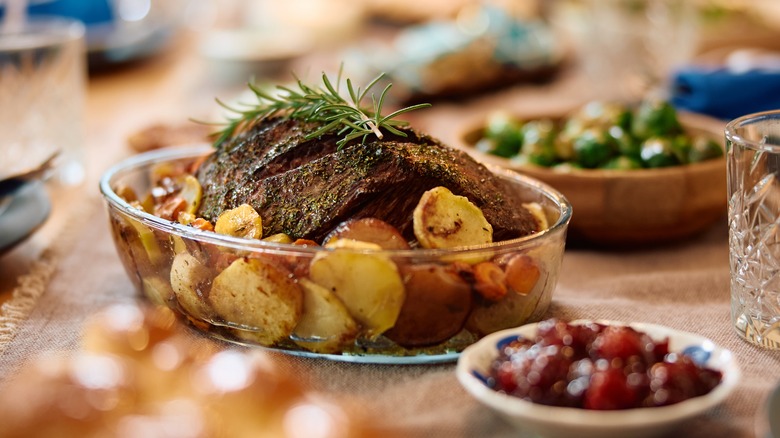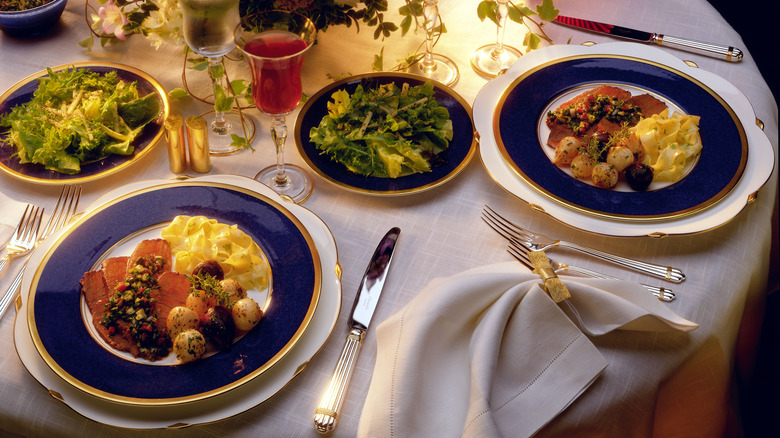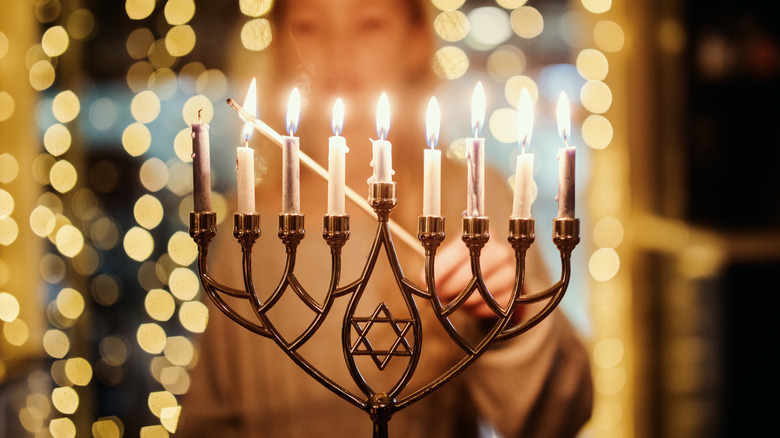Eating Brisket During Hanukkah Goes Further Back Than You'd Expect
Next to crispy fried latkes and delicious chocolate Hanukkah gelt, the feature of many Hanukkah gatherings is a slow-cooked brisket. Brisket is a staple at many Jewish holidays, including Passover, Rosh Hashanah, and Shabbat. Brisket comes from the chest of a cow, on the front of the animal, making it a kosher cut of beef. This means that the meat is produced and derived according to specific rules under Kashrut, Jewish laws that guide the consumption of foods. Not every cut of brisket is kosher, as kosher foods require kosher-certified processing. However, the dish is usually a safe bet for those looking for a kosher cut.
But it's not just its kosher status that made brisket into a Jewish holiday tradition. A brisket is a large cut of beef that is best cooked slowly, making it the perfect dish to prepare for large gatherings. Brisket became especially popular among Ashkenazi Jewish communities because of its size, kosher status, and low price point. Brisket, because it is not a tender cut of beef, was often inexpensive, and therefore more accessible than other dishes. However, brisket's popularity goes beyond its kosher status and low price point. It has become a staple that has taken on a life of its own, with many keeping their family recipe as a prized possession, passed down through the generations.
A slow-cooked history of brisket
Like many traditional Jewish dishes, the history of brisket goes back to the shtetl, or small predominantly Ashkenazi Jewish towns that were located in Eastern Europe. Of course, brisket is served all over the world. But brisket as a Jewish dish has its roots in its availability to poorer communities thanks to its low price point. Because brisket is mostly muscle, it has a tendency to be tough. However, this also allowed for slower cooking, and its low price point made it an attainable dish for many families who struggled to afford other cuts of meat.
When the Ashkenazi Jewish population immigrated to the United States, they also brought with them their traditional foods, such as brisket. Other foods, such as Challah bread and babka also made their way over to the United States, and have since become a staple in Jewish-American cooking. And brisket in particular has made its way into mainstream American cuisine, especially for fans of barbecue. Brisket, thanks to its tendency to thrive on slow and slow cooking, makes for a barbecue staple. In fact, barbecued brisket comes from the exchange of brisket recipes and traditions between Jewish communities and Texas ranchers, making brisket a true American classic.
A holiday staple
But one cannot make a Hanukkah dinner with brisket alone. Though it is a substantial, tasty, and nostalgic main dish, it is only one of many foods enjoyed during Hanukkah. After all, Hanukkah is also known as the Festival of Lights. Hanukkah, which means 'dedication', commemorates the reclamation of the Temple of Jerusalem after Greek and Syrian forces attempted to impose their religion on the Jewish people. In 164 BCE, when the Maccabees retook their temple, they were left with only one day's worth of purified ceremonial oil, which they managed to stretch for eight days until a new supply was available.
Because of this, oil-rich foods have proven to be a staple during the holiday. Perhaps the most iconic Hanukkah food is latkes or potato pancakes, which are often served with applesauce or sour cream. Another dish served during Hanukkah is sufganiyot, which is fried doughnuts that are filled with jelly. But besides these delicious and oil-rich treats, only one dish will do for dinner during Hanukkah, and that's the delicious and slow-cooked brisket.


